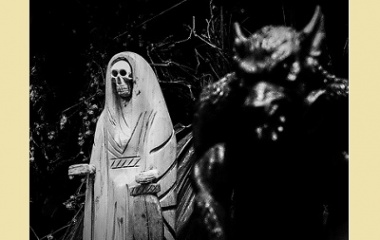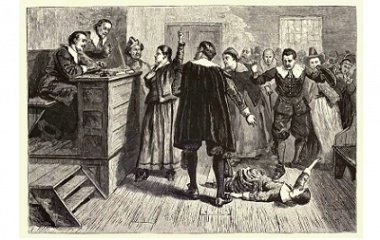Shamans, healers, sorcerers, witches and diviners have long been outside the purview of rigid societal constructs, much to the chagrin of anthropologists, theologists and others determined to invalidate such ancient practices through their narrow worldview.
What Is Witchcraft?
Witchcraft is the practice of magic and sorcery to positively or negatively influence a situation or person. Though stereotypical concepts of witches are still perpetuated in the modern media, there is more to the concept than an evil old hag and her black cat practicing black magic. The term also refers to the Witch Hunts in the Early Modern Period, as well as the modern practice of witchcraft, known as Wicca. The derivation of the word witchcraft is from Old English wiccecraeft, which means the craft of someone who practices sorcery. Due to differing cultural interpretations of the term, and its meaning changing over time, it remains problematic to define clearly.
The Witch Hunts
According to the Malleus Maleficarum, a book written by a Catholic clergyman, Heinrich Kramer, in 1487, witches needed to be tortured and put to death. The title of his book translates as The Hammer of Witches and his work had a great influence on the thinking at the time with regard to witchcraft. The alleged sorcerers were accused of entering into pacts with the devil, according to Kramer, along with general beliefs purporting they killed babies, danced around naked and had orgies. From the 11th century, witchcraft began to be associated with heresy and evil. By the 14th century, witches were charged with maleficium, meaning malevolent sorcery, along with the additional charge of diabolism. Between the 14th and 18th century, the witch trials were at their peak and, scholars claim, approximately 12 000 witches were executed in Europe during this period.
In the Americas
The Salem witch trials, from 1692-93, are perhaps the most renowned account of the persecution of witches in America. More than 300 people were accused of witchcraft but, surprisingly, only 29 were convicted and put to death.
In North America Indian tribes, such as the Navajo, witches can allegedly transform into an animal when they are clad in the dead animal’s skin. They are called skin-walkers and are able to perform acts in secret in their alternate form. In Chile, the indigenous people, known as the Mapuche, believe witchcraft is used to gain the upper hand in a situation or conflict or can be used to cause harm through the use of evil forces. Scholars report the Mapuche have been accused of destroying the livestock or crops of neighboring tribes with witchcraft.
In Europe
In ancient Roman times, witches were burnt alive, when their spells resulted in someone’s death. During the imperial period, which ended in approximately the 4th century AD, Rome was said to house many occultists. Though many of the emperors banned magic at the time, they were still known to have a wizard and astrologer under their employ, to consult with daily.
With the arrival of Christianity in Europe, believers in witchcraft were then thought of as superstitious, and practitioners of the craft became known as heretics. In the High Middle Ages, after Christianity had begun to settle in, a strange combination of magic and Christian practices existed for a period. Even monks practiced magic, mostly in the form of healing with medicinal herbs. Magic was mixed in with the healing process through potions and charms. This gave way to the later Middle Ages and the era of the Witch Hunts.
In the Philippines
Black and white magic is practiced in the Philippines. The folk magic, called kulam, has its origins in pre-Colonial religion, and is said to be mixed with Catholicism. One of the islands, Siquijor, is well-known for witchcraft even today. The witches on Siquijor prefer to be referred to as traditional healers and are reputed to have psychic and telekinetic abilities.
In Japan
In Japanese culture, the existence of witchcraft is an ancient belief. Witchcraft was blamed for things like natural disasters, illness and bad luck. People believed evil spirits, called tsukimono, took the form of animals and possessed people, resulting in dire misfortune for the possessed. A fox was the most common animal used in witchcraft. According to scholars, the magical fox may have been owned by a single person or kept as pet in a family. Unfortunately, those that owned a tsukimono were feared, and often ostracized as a result. Since the creature was passed down the female side of the family, the women found it nearly impossible to get married. This may have been a possible cause for them being labelled as witches.
In Russia
Since Russia was one of the last Pagan strongholds before Christianity was introduced, witchcraft has a strong influence in the country’s history and on people’s current day lives. People relied on witches for healing the sick, harvesting rituals, midwifery and marriages. The witch’s spells even included keeping one’s partner faithful and shape-shifting! Witches would invoke a wolf in order to perform shape-shifting spells. During the witch trials in Russia, three-quarters of the accused were men, and there was no accusation of diabolism, unlike in the witch trails in Western Europe.
In Africa
In Africa, witchcraft is deeply embedded in many regional cultures. One could expect to find traditional diviners or inyanga, witches or thakathi, and traditional healers or sangomas still practicing in many countries today. A thakathi is a person who wishes malevolence on others, while sangomas and inyanga deal with spiritual and emotional healing, births, deaths and communicating with the ancestors. They tap into the African cosmology, which includes ancestors and spirits, and act as mediums by communicating with these worlds, usually by entering a trance.
In Central Africa, some cultures believe diseases such as AIDS are the result of evil magic. Children in the Democratic Republic of Congo are thrown out of their houses if accused of witchcraft, and subjected to violent exorcisms from fake pastors. In Ghana, women suspected of being witches are banished from their homes and sent to camps where hundreds of other accused witches are held. According to traditional Malawian beliefs, one can scare away a witch with money. The country still adheres to a witchcraft act established in colonial times, and some people believe that when witches see money they become naked and confused.
On the African continent, muti murders are still rife. Muti means the use of human body parts in traditional black magic. The best muti apparently comes from live victims. The victim’s screams allegedly make the organs more powerful. Albinos are frequently murdered as they are believed by some to provide even more potent muti.
Modern Witchcraft
Modern day witchcraft exists today in the form of Wicca, a part of the Neo-Pagan movement. Practitioners draw from old pagan beliefs and worship a goddess and god. The spiritual system affirms a harmonious relationship with nature and believes there is divinity in all things. Wiccans celebrate the cycles of nature and perform spells to improve healing, wisdom, love and harmony.
Witchcraft has been around for more than a thousand years, predating organized, monotheistic religions like Christianity. It has formed an intrinsic part of everyday life, providing guidance, healing, protection, communication with the spirits and bringing about harmony with nature. The peaceful way of life only became feared under the influence of Christianity, when the Christians’ perhaps self-righteous viewpoint labelled witchcraft as evil and heretic.











I need help with some court issues I’m here in Okeechobee Florida and I am facing some serious time and really not in the best of shape mentally to go through with this my name is David Sherrod and I’m reaching out and seeking for help so if there anybody out there pray for me I go to court Thursday on the 28th.. My facebook page is the same as my name.. Thanks in advance but I don’t want no one to be sacrifice for me I don’t want no one to lose their life are become sickly I only want positive thoughts and prayers and support and encouragement and love and outcomes..